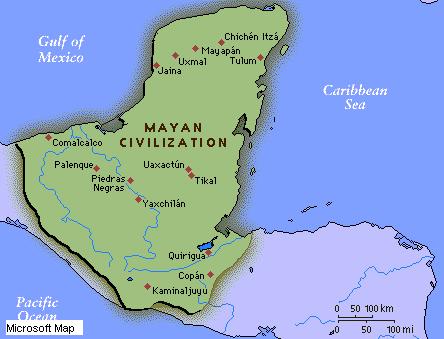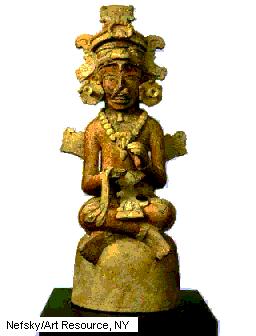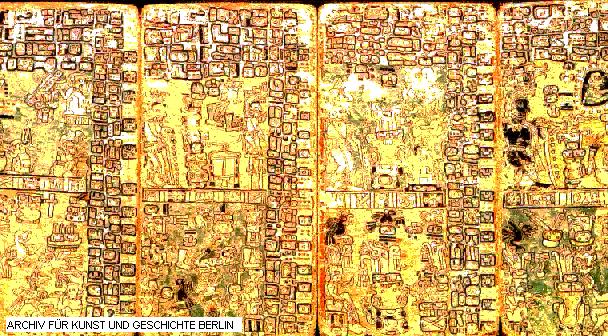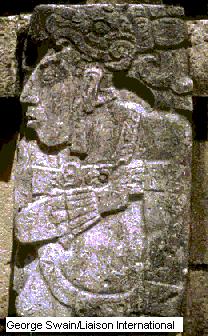| Mayan
Civilization
Maya, group of related Native American
nations of the Mayan linguistic stock, living in Mexico, in the states
of Veracruz, Yucatán, Campeche, Tabasco, and Chiapas, and also in
the greater part of Guatemala and in parts of Belize and Honduras. The
best-known people, the Maya proper, after whom the entire group is named,
occupy the Yucatán Peninsula. Among the other politically significant
peoples are the Huastec of northern Veracruz; the Tzental of Tabasco and
Chiapas; the Chol of Chiapas; the Quiché, Cakchiquel, Pokonchi,
and Pokomam of the Guatemalan highlands; and the Chortí of eastern
Guatemala and western Honduras. With the exception of the Huastec, these
peoples occupy contiguous territory. They were all part of a common civilization,
which in many respects achieved the most complex level of development among
the original inhabitants of the whole of the western hemisphere.
Agriculture formed the basis of the Mayan
economy in pre-Columbian times, maize being the principal crop. Cotton,
beans, squash, manioc (or Cassava), and cacao were also grown. The techniques
of spinning, dyeing, and weaving cotton were highly perfected. The Maya
domesticated the dog and the turkey but had no draught animals or wheeled
vehicles. They produced fine pottery, unequalled in the New World outside
of Peru. Cacao beans and copper bells were used as units of exchange. Copper
was also used for ornamental purposes, as were gold, silver, jade, shell,
and colourful feathers. Metal tools, however, were unknown. The Mayan peoples
were ruled by hereditary chiefs, descended from the male line, who delegated
authority over village communities to local chieftains. Land, held in common
by each village, was parcelled out by these chieftains to the separate
families.

 back to top back to top
Architecture
Mayan culture produced a remarkable architecture,
of which great ruins remain at a large number of sites, including Palenque,
Uxmal, Mayapán, Copán, Tikal, Uaxactún, and Chichén
Itzá. These sites were vast centres for religious ceremonies. The
usual plan consisted of a number of pyramidal mounds, often surmounted
by temples or other buildings, and grouped around open plazas. The pyramids,
built in successive steps, were faced with cut stone blocks and generally
had a steep stairway built into one or more of their sides. The substructure
of the pyramids was usually made of earth and rubble, but sometimes mortared
blocks of stone were used. The most common type of construction consisted
of a core of rubble or broken limestone mixed with mortar, and then faced
with finished stones or stucco. Stone walls were also frequently laid without
mortar. Wood was used for door lintels and for sculpture. The arch was
not known, but its effect was approximated in roofing buildings by making
the upper layers of stone of two parallel walls approach each other in
successive projections until they met overhead. This system, requiring
very heavy walls, produced narrow interiors. Windows were rare and were
small and narrow. Interiors and exteriors were painted in bright colours.
Exteriors received special attention and were lavishly decorated with painted
sculpture, carved lintels, stucco mouldings, and stone mosaics. The decorations
generally were arranged in wide friezes contrasting with bands of plain
masonry. Commoners' dwellings probably resembled the adobe and palm-thatched
huts seen today among Mayan descendants.
Maya
Mayan civilization dominated southern
Mesoamerica in the second half of the first millennium AD. Although originating
in the Pre-Classic period, Mayan culture reached its artistic and intellectual
apex during the Late Classic phase, from about 600 to about 900. By the
time of the Spanish conquest it was in decline.
In the variety and quality of their architecture,
the Maya were unrivalled by any other pre-Columbian civilization. Classic
Mayan sites are primarily found in lowland tropical areas. With proportionally
more emphasis on ceremonial features, they appear to be less truly urban
than Teotihuacán. The majority of Mayan ruins are in Mexico; they
include Palenque, Yaxchilán, and Bonampak and, in the Yucatán
Peninsula, Chichén Itzá, Coba, Dzilbilchaltun, Edzna, Hochob,
Kabah, Labná, Sayil, Uxmal, and Xpuhil. Other major sites are Copán
in Honduras and, in Guatemala, Piedras Negras, Quirigua, and Tikal, the
largest of all Mayan ceremonial centres. Mayan architecture is characterized
by an exquisite sense of proportion and design and by structural refinement
and subtle detailing. The Maya used sculpture more extensively for architectural
decoration than any other pre-Columbian civilization. The corbel arch was
employed not only to vault interior spaces, but also to construct free-standing
arches. The Maya also built paved roadways connecting major religious and
administrative centres; these seem to have been used mostly for ceremonial
processions and to symbolize political links.
Mayan art is the most highly refined and
elegant of any pre-Columbian civilization. It has dignity and majesty,
and is exuberant and sensual, with lavish ornamentation.
Stelae with figurative carving and inscriptions
are the most characteristic examples of the monumental free-standing stone
sculpture of the Maya. The most elaborate examples are found at Copán,
where the softness of the stone made possible Baroque flamboyance of ornament.
Most major sites have well-developed traditions of architectural relief
panels in stone, and at Palenque stucco was effectively used for reliefs.
The Maya mastered all known pre-Columbian
art forms except metalworking. Although no Mayan textiles remain, their
character and decoration can be discerned from representations in painting,
figurines, and sculptures. Jade was skilfully carved, as were wood, bone,
and shell; in clay, however, the Maya excelled. Realistic figurines (especially
those from the island of Jaina) and polychrome pottery with mythological
or genre scenes (produced at Chama) are among the finest accomplishments
of pre-Columbian painted pottery.
Particularly fine examples of Mayan fresco
painting have been found at Bonampak, Palenque, and Tikal. The Maya also
produced codices, with hieroglyphic script. Of the surviving Mayan codices,
the Dresden Codex (Sachsische Landesbibliothek, Dresden, Germany) best
illustrates the Maya's descriptive and formally dynamic use of line.

"Pre-Columbian Art and Architecture," Microsoft(R)
Encarta(R) 98 Encyclopedia. (c) 1993-1997 Microsoft Corporation. All rights
reserved.
 back to top back to top
Writings
The Mayan peoples developed a method of
hieroglyphic notation and recorded mythology, history, and rituals in inscriptions
carved and painted on stelae (stone slabs or pillars), on lintels and stairways,
and on other monumental remains. Records were also painted in hieroglyphs
and preserved in books of folded sheets of paper made from the fibres of
the maguey plant. Four examples of these codices have been preserved: the
Codex Dresdensis, now in Dresden; the Perez Codex, now in Paris; and the
Codex Tro and the Codex Cortesianus, both now in Madrid. The Codex Tro
and Codex Cortesianus comprise parts of a single original document, and
are commonly known under the joint name Codex Tro-Cortesianus. These books
were used as divinatory, almanacs containing topics such as agriculture,
weather, disease, hunting, and astronomy.
 Codex Tro
One of the four preserved codices of Mayan hieroglyphs, the Codex
Tro dates from about the 14th century. These ornate pages from the Codex
form part of a prophetic calendar that predicts good and bad days. The
ancient Maya used paints made of natural pigments and paper made from the
fibres of maguey plants to record religious information and historical
events.
Codex Tro
One of the four preserved codices of Mayan hieroglyphs, the Codex
Tro dates from about the 14th century. These ornate pages from the Codex
form part of a prophetic calendar that predicts good and bad days. The
ancient Maya used paints made of natural pigments and paper made from the
fibres of maguey plants to record religious information and historical
events.
"Codex Tro," Microsoft(R) Encarta(R) 98 Encyclopedia.
(c) 1993-1997 Microsoft Corporation. All rights reserved.
 back to top back to top
Calendar
and Religion
Chronology among the Maya was determined
by an elaborate calendar system. The year began when the sun crossed the
zenith on July 16 and consisted of 365 days; 364 of the days were grouped
into 28 weeks of 13 days each, the new year beginning on the 365th day.
In addition, 360 days of the year were divided into 18 months of 20 days
each. The series of weeks and the series of months both ran consecutively
and independently of each other; however, once every 260 days, that is,
the multiple of 13 and 20, the week and the month began on the same day.
The Mayan calendar, although highly complex, was the most accurate known
to human beings until the introduction of the Gregorian calendar in the
16th century.
The Mayan religion centred on the worship
of a large number of nature gods. Chac, a god of rain, was especially important
in popular ritual. Among the supreme deities were Kukulcan, a creator god
closely related to the Toltec and Aztec Quetzalcoatl, and Itzamna, a sky
god. A Mayan trait was their complete trust in the gods' control of certain
units of time and of all peoples' activities during those periods.

From the Pre-Columbian period to the present
day, the Maya people have inhabited an area centred on the Yucatán
Peninsula, western Mexico. Maya civilization reached its high point between
the 3rd and 10th centuries AD, but some Maya centres continued to flourish
up to the Spanish Conquest. The Maya kept written records in their hieroglyphic
script, which has still to be fully deciphered, and practised sophisticated
astronomy and mathematics. Almost the whole of Maya literature was destroyed
during the Conquest, so that the detailed nature of what was evidently
a highly complex mythology is difficult to reconstruct with any certainty.
The most important source for Maya mythology
is the Popol Vuh ("Book of Advice"), which was written in the Quiché
Maya dialect but in European script soon after the Conquest. The Popol
Vuh presents versions, sometimes possibly with a Christianized colouring,
of many myths and legends. One main element is an account of the Maya cosmogony,
in which the universe is conceived on three levels: an underworld; a middle,
earthly world; and a heavenly realm. The four corners of the world were
marked by different colours and supported by four Atlantean deities corresponding
to the colours and directions: Mulac-white-north; Kan-yellow-east; Cauac-red-south;
and Ix-black-west. The great Ceiba tree connected all three levels and
provided a route along which the souls of the dead and the gods could travel.
The gods made several attempts to create humans-out of mud, wood, and finally
maize.
The principal Maya deity was Itzamná
("Lizard House"), who was the supreme creator and Moon deity, and the patron
of writing and learning. He shares some characteristics with another major
deity, Kukulcán ("Feathered Snake Who Traverses the Waters"), who
was later adopted by the Aztec mythology as Quetzalcoatl. Itzamná's
consort was Ix Chel ("Lady Rainbow"), the goddess of childbirth, weaving,
and medicine. The Sun god, Ahau Kin, took the form of a jaguar to travel
through the underworld between sunset and sunrise.
The Popol Vuh also describes the exploits
of the heavenly twins Hunahpu and Xbalanque, who were challenged to a ball
game by the Lords of Xibalba (the underworld). Through bravery and cunning
the twins survived many trials before engaging the gods in a game. The
gods were impressed by the twins' ability to dismember then put themselves
back together again. When the gods allowed themselves to be cut up, however,
the twins left them in pieces, thus winning the contest. After this, Hunahpu
and Xbalanque were deified as the Sun and Moon.
"Native American Mythology," Microsoft(R)
Encarta(R) 98 Encyclopedia. (c) 1993-1997 Microsoft Corporation. All rights
reserved.
 back to top back to top
Linguistic
Stock
Maya, (called also Yucatec), the language
of the Maya proper, is spoken by about 350,000 people in Yucatán,
Guatemala, and Belize. The other languages of the Mayan stock include the
language of the Huastec and several groups of closely affiliated languages.
 back to top back to top
"Maya," Microsoft(R) Encarta(R) 98 Encyclopedia.
(c) 1993-1997 Microsoft Corporation. All rights reserved.
|

